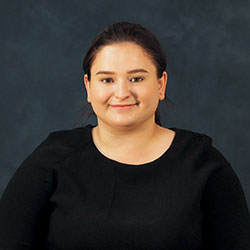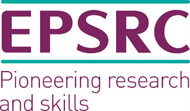Tamsin O'Reilly
Tamsin Isabel O’Reilly
I joined the CDT in September 2017 after completing a Masters in Chemistry (MSci) at Queen’s University Belfast (QUB).
CDT PhD/EngD Project Title: “Exploring domain cross-talk and cycling effects in polycrystalline ferroics”
Primary Supervisor: Dr. Miryam Arredondo-Arechavala (QUB)
Secondary Supervisor: Dr. Damien McGrouther (UofG)
Polycrystalline ferroics are essential materials that form the basis of many of today’s device technologies, including sensors and non-volatile memory devices. The key characteristic of a ferroic material is the development of equivalent ground states, called domains, that form to minimise the free energy of the system when the material undergoes a ferroic phase transition. Ferroic materials exhibit at least one of the primary ferroic properties, where in which domains appear from origins in structural shear (ferroelastics), magnetic moments (ferromagnetics) or electric dipole moments (ferroelectrics). The functionality of ferroics arise from the reversible switching of domains, which are physically separated by domain walls. Many of the electrical and mechanical properties of ferroelectric materials, for example, are governed by the formation and mobility of domains and their domain walls. The domain pattern greatly influences the final properties of the material and it is now widely accepted that the macroscopic properties of ferroic materials are due to the domains and domain walls’ collective phenomena that occurs on the nanoscale.
Recently, there has been increasing interest in the investigation of the domain patterns in polycrystalline ferroelectrics. Most ferroelectrics in use are polycrystalline, because of their low-cost and fast preparation time-scales. In comparison to their single crystal counterparts, the polycrystallinity of these materials adds an additional parameter that will influence the final domain structure within the single crystal grains, due to the elastic and electrostatic compatibility that exists between grains. As a result, polycrystalline ferroics have intricate domain patterns and the characterisation of the domains are a challenge and generally considered to be difficult. Most studies on these materials have been driven by piezoresponse force microscopy (PFM) experiments. Despite its great advantage to probe domain structures, artefacts often appear in PFM imaging due to tip-surface interactions and the technique has spatial and time resolution limitations. In recent research, evidence has been found that there is a profound grain size/domain size relationship in ceramic ferroelectric materials. Therefore, grain orientation and grain size play a crucial role in domain switching and evolution which will ultimately govern the material’s properties. Moreover, the possibility of domain cross-talk across grains has been elucidated and macroscopic observations of domain structures in polycrystalline ferroelectrics show that domain walls will regularly traverse across grain boundaries; suggesting domain continuity across grains. However, the conditions needed for this to occur are not yet fully understood. In order to optimise the use of polycrystalline ferroics and gain full control over domains for future technological applications, it is imperative to improve our understanding of domain compatibility across grain boundaries in a static and dynamic manner (during the application of external stimuli).
In this study, polycrystalline BaTiO3 (BTO) is used as a model system to investigate domain compatibility across grains and their associated domain dynamics under in-situ heating conditions. BTO is often described as a ‘seminal’ or ‘didactic standard’ ferroelectric because, since its discovery over 80 years ago, it has remained a widely-used and attractive material for industry and research alike. Studies will be conducted to explore whether domains of individual grains of a polycrystalline ferroic behave in a similar way to that of single crystals, and the conditions needed for domains to couple across grain boundaries in a stress-free manner will be investigated. This will involve characterisation of the grains by electron backscatter diffraction (EBSD), lamellae fabrication fabricated by focused ion beam (FIB) and subsequently in-situ heating transmission electron microscopy (TEM) studies.
General Research/Science Interests:
My main research interest is using advanced in situ transmission electron microscopy (TEM) techniques to probe the dynamics of functional materials under various external stimuli. In situ microscopy is a fascinating area of research that is continually developing, due to advances in microscope instrumentation and dedicated in situ TEM holders.
Successful Funding:
In January 2020, we successfully applied for funding from the European Horizon 2020 research and innovation programme (under grant agreement No 823717 – ESTEEM3). ESTEEM3 – Enabling Science and Technology through European Electron Microscopy – is an EU funded project, which provides users with transnational access services to research institutions with state-of-the-art electron microscopy capabilities. To date, I have conducted two research trips at the Ernst Ruska Centre (ER-C) in Jülich, Germany. The research project involved using advanced strain mapping techniques, such as dark field electron holography (DFEH) and nanobeam electron diffraction (NBED) to study local strain fields in ferroelectric BaTiO3 as a function of in situ heating.
Talks / Presentations:
“Resolving Pseudosymmetry via EBSD in Polycrystalline BaTiO3”
EBSD Meeting 2019, National Physical Laboratory (NPL), April 2018.
- Poster presentation.
“Exploring heat cycling effects on domain patterns in ferroelectrics using in situ TEM”
Microscopy Society Ireland 2020, Dublin, January 2020.
- Poster presentation.
“Thermally driven domains in BaTiO3: an in-situ study”
Virtual Early Career European Microscopy Congress, virtual event, November 2020.
- Poster presentation.
“Thermally driven domains in BaTiO3: an in-situ study”
MRS Spring and Fall Meeting, virtual event, November 2020.
- Oral presentation.
CDT Involvement:
I am passionate about promoting diversity and inclusivity in STEM through public engagement activities, therefore I actively seek to represent the CDT at such events. In February 2018, I volunteered at the NI Science Festival with CDT PIADS. Our stall had a variety of demos and mini-experiments that aimed to inspire a young audience of the wonders and magnetism and data storage technologies. Also in 2018, the CDT PIADS group successfully applied for funding from the RAENg Ingenious awards scheme and, in partnership with local radio stations in both Northern Ireland and Scotland, delivered two radio programmes. The main aims were to engage with local communities, encourage young scientists and raise awareness for diversity in engineering amongst people of all ages and backgrounds. I participated in the NI radio show, where myself and other students showcased our passion for science, talked about our innovative research and discussed our career path which led to joining the CDT. In March 2019 I presented a poster at the IPIC Annual Industry Workshop at the Tyndall institute in Cork and recently took part in a “Speed-dating for PhDs” PhD networking event for PhDs and the IPIC Summer interns.
Impact Activity:
I am very fortunate to have taken part in various training courses in my PhD. In Summer 2019, I completed the Electron Microscopy Summer School at the University of Leeds, which made me fall in love with electron microscopy. At Queen’s University, I took part in advanced electron microscopy training on our TALOS TEM as well as training in the use of the DENS climate holder system. I also enjoy providing training. Currently, I am delivering a set of virtual ‘Focused Ion Beam (FIB) masterclasses’ to introduce new users to our FIB microscopes.
Any other info?
If you can’t find me in the lab, I am usually out on the golf course missing fairways and putts!
Testimonial:
The most positive aspect of my CDT experience has been the opportunity to travel to other research institutions, where I have conducted advanced research and built valuable collaborations.
Contact me:
Email: toreilly03@qub.ac.uk
Linked in: https://www.linkedin.com/in/tamsin-o-reilly-886888172






